Starting a home recording studio doesn’t have to drain your wallet. The first step is picking a reliable audio interface. It is a small device that connects your microphone or instrument to your computer for clean, low-latency sound. In this guide, we focus on the best audio interface options you can buy for around $150. We will keep things simple and beginner-friendly so you can start recording with confidence right away.
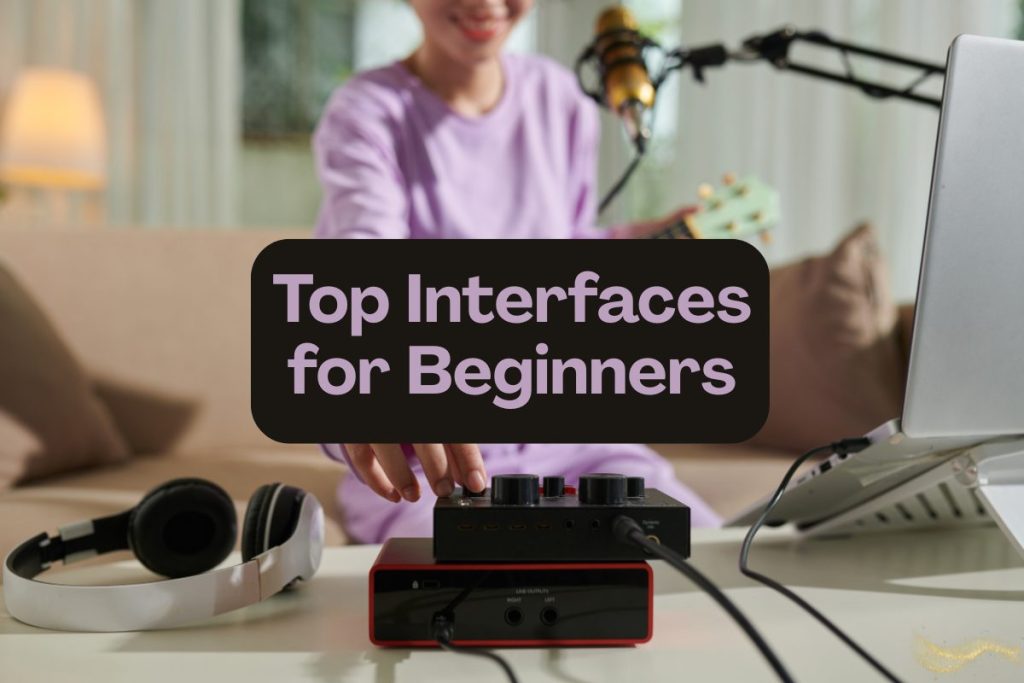
Table of Contents:
4. Best for Podcasters & Streamers
5. Best for Singer-Songwriters
6. Best Affordable Two-Input Interface
How to choose the correct audio interface?
Frequently Asked Questions about a beginner-friendly audio interface around $150
Factors we considered
When choosing the best budget audio interface, we focused on the features that actually affect your recordings.
Inputs and Outputs (I/O)
One XLR input is enough for solo vocals or podcasts, while two combo inputs (XLR + Hi-Z) suit singers who also play guitar. Balanced outputs help when you add studio monitors in a home recording studio.
Preamps and Phantom Power
Quality preamps keep recordings clean. All picks also provide +48V phantom power, required for condenser mics.
Latency and Direct Monitoring
Latency is the delay between playing and hearing yourself. Interfaces with direct monitoring fix this, giving real-time sound.
Driver Support
Stable drivers, especially on Windows, make recording smoother. Reliable ASIO or class-compliant drivers are a must for an audio interface for PC.
These factors guided us to the most practical budget audio interface options for beginners.
Here’s Our Top Picks
| Focusrite Scarlett Solo (4th Gen) | Simple, reliable, and widely recommended. The Scarlett Solo offers one mic input with Air mode and an instrument input. It’s perfect for solo singers, podcasters, and anyone starting a home recording studio. You get an easy, dependable interface without extra complexity. Read More. |
| Universal Audio Volt 1 | Known for its Vintage preamp mode, the Volt 1 adds warmth and character to the voice and acoustic instruments. It’s a strong choice for beginners who are focused mainly on vocal recording. You still get studio-like sound at an entry-level price. Read More. |
| Arturia MiniFuse 1 | The MiniFuse 1 is portable yet powerful. It comes with a single combo input, a loopback function, and a USB hub for extra gear. It’s ideal for creators who want a travel-friendly budget audio interface for PC or Mac without losing useful features. Read More. |
| PreSonus Studio 24c | With two XMAX-L preamps, MIDI I/O, and handy input meters, the Studio 24c is versatile for recording duos, interviews, or streaming setups. Direct monitoring and a solid software bundle make it a balanced pick for content creators. Read More. |
| Behringer UMC202HD | The UMC202HD delivers 2 Midas-designed preamps, 24-bit/192 kHz quality, and direct monitoring. It’s the best choice if you need two inputs on a tight budget, though driver setup requires a bit more attention. Read More. |
| Native Instruments Komplete Audio 1 | Designed with simplicity in mind, the Komplete Audio 1 gives you one mic and one instrument input, clean sound, and bundled music software. A strong pick for singer-songwriters looking for an easy start with both vocals and guitar. Read More. |
Best Overall Beginner Pick – Focusrite Scarlett Solo (4th Gen)
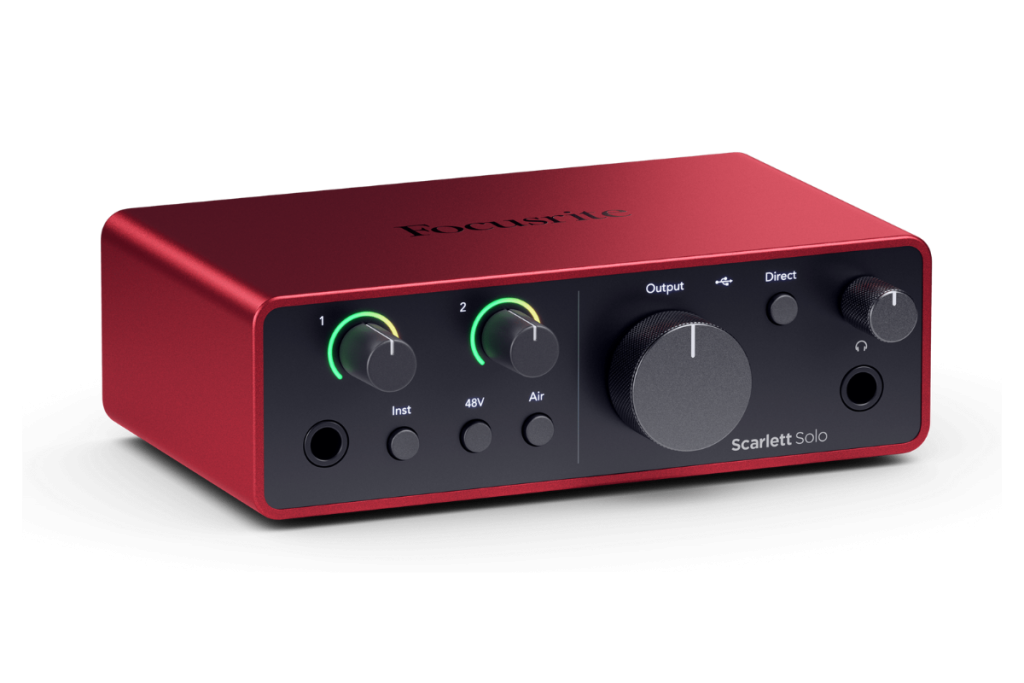
Key Features & Specs
- 1 XLR mic input with high-quality preamp
- 1 Hi-Z instrument input
- 2 balanced line outputs
- Air mode for brighter, polished sound
- 24-bit / 192 kHz recording resolution
- Direct monitoring (software-controlled) with loopback
Best Use Cases, Strengths, and Limitations
| Best Use Cases | Strengths | Limitations |
| 1. Solo vocalists recording at home. 2. Podcasters who need one mic input. 3. Singer-songwriters who want to record voice and guitar separately. | 1. Clean, professional preamp sound. 2. Air mode adds studio-like character. 3. Compact and easy to carry. 4. Widely supported by recording software. | 1. Only one mic input — not suited for duos 2. Lacks MIDI I/O for keyboards or synths 3. Basic layout may feel limited as you grow |
Why We Picked It
The Scarlett Solo is a top budget audio interface because it balances quality and simplicity.It’s plug-and-play, reliable, and delivers clean recordings. Perfect for a first home studio.
Check Price:
Best for Vocals – Universal Audio Volt 1
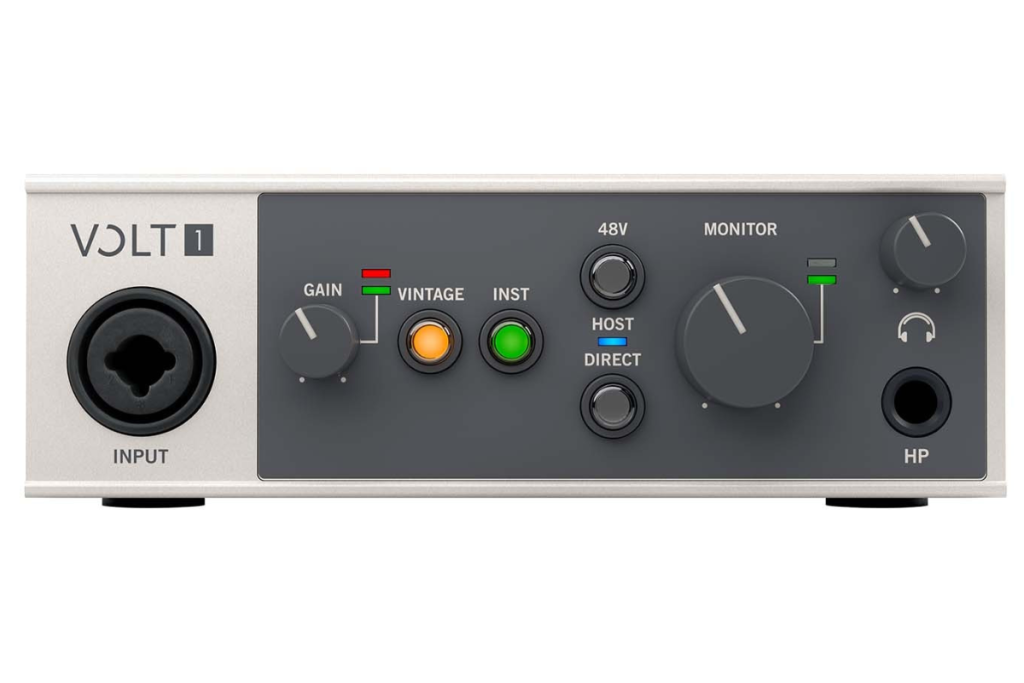
Key Features & Specs
- 1-in / 2-out desktop USB-C interface, 24-bit / 192 kHz conversion
- Vintage Mic Preamp mode for warm, tube-style tone
- Direct Monitoring for zero-latency recording
- Bus-powered, class-compliant (Mac, PC, iPad, iPhone)
- Studio-quality headphone amp + 48V phantom power
- MIDI In/Out (1×1) for controllers and synths
- Rugged, stylish build for reliable use
Best Use Cases, Strengths, and Limitations
| Best Use Cases | Strengths | Limitations |
| 1. Vocal recording for singers and voiceovers 2. Solo acoustic instruments like guitar or piano 3. Home studio setups where vocal quality is the top priority | 1. Vintage switch noticeably improves vocal tone 2. Solid build quality with stylish design 3. Low-latency direct monitoring 4. Reliable USB-C connection (USB-C to USB-A cable included) | 1. Only one input, so not ideal for duos or simultaneous guitar + vocal takes 2. Slightly pricier than some one-input competitors |
Why We Picked It
Universal Audio is known for pro studio gear, and the Volt 1 brings that sound to a budget interface. Its Vintage mode adds warmth and presence. This makes vocals sound richer without extra plugins.
Check Price:
Best Compact Option – Arturia MiniFuse 1
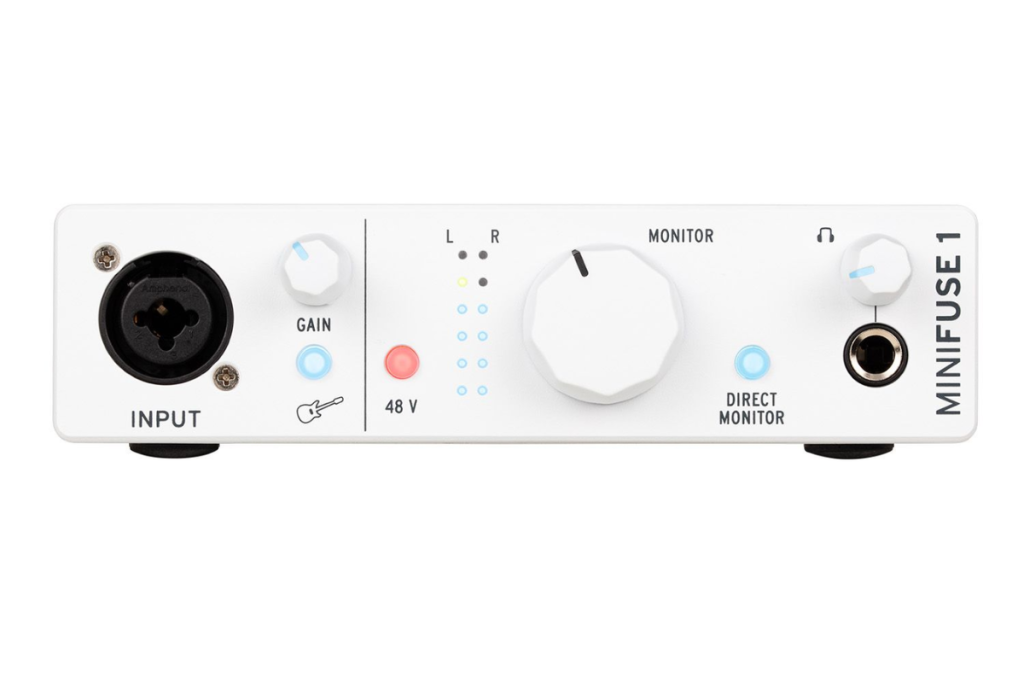
Key Features & Specs
- 1 XLR/¼″ combo input (mic/line/Hi-Z)
- 1 XLR/¼″ combo input (mic/line/Hi-Z) with 48V phantom power
- 2 balanced TRS line outputs with volume control
- 1 stereo headphone output with volume control
- Loopback function for streaming and podcasting
- Direct Monitor switch
- USB-C interface with additional USB2 Type-A hub (250mA max.)
- Bus-powered, compatible with PC and Mac
Best Use Cases, Strengths, and Limitations
| Best Use Cases | Strengths | Limitations |
| 1. Mobile or travel-friendly home recording studio setups. 2. Podcasters and streamers needing loopback. 3. Beginners who want one input and a simple workflow. | 1. Very compact and lightweight. 2. USB hub port adds flexibility for laptops with few ports. 3. Loopback feature is rare at this price point. 4. Includes a generous software bundle. | 1. Only one input, limiting simultaneous recording. 2. No MIDI I/O for connecting external keyboards. |
Why We Picked It
The MiniFuse 1 is a compact budget interface that saves space on your desk.
It delivers solid recording quality and extras like loopback, perfect for streamers and online teachers.
Check Price:
Best for Podcasters & Streamers – PreSonus Studio 24c
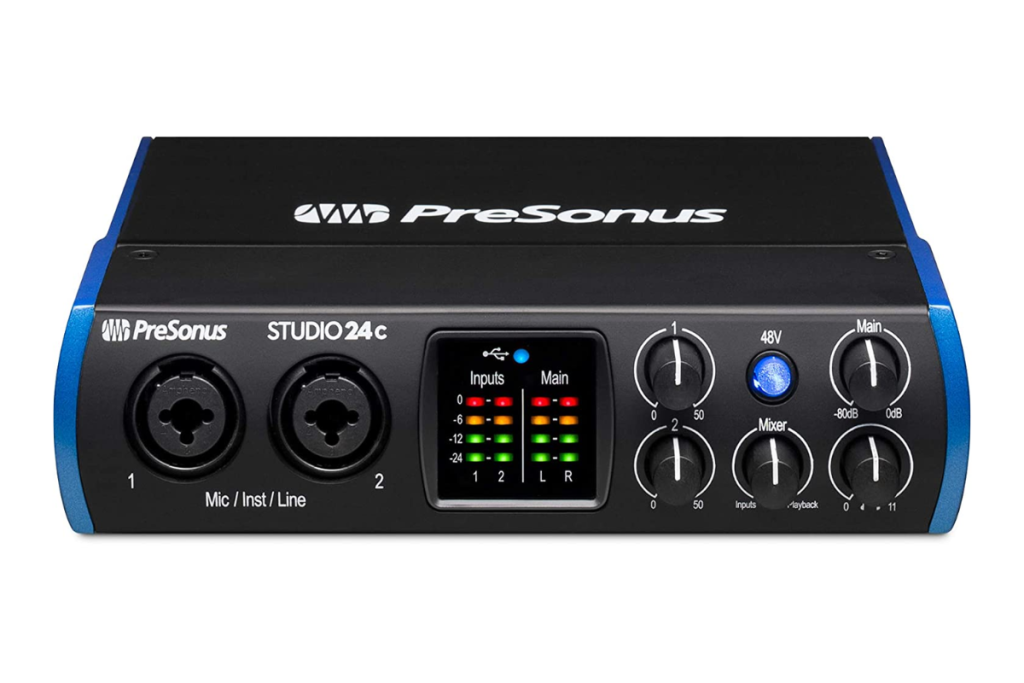
Key Features & Specs
- 2 XLR/¼″ combo inputs with XMAX-L preamps
- 2 balanced ¼″ TRS main outputs + headphones out
- 24-bit / 192 kHz recording quality
- MIDI In/Out (1×1)
- Mix knob for direct monitoring
- USB-C connectivity (cables for USB-C and USB-A included)
Best Use Cases, Strengths, and Limitations
| Best Use Cases | Strengths | Limitations |
| 1. Beginners wanting two inputs at the lowest cost. 2. Singer-guitarists recording simultaneously. 3. Entry-level podcasting or duo interviews. | 1. Extremely affordable for a 2-in/2-out interface. 2. Solid preamp quality with phantom power. 3. Direct monitoring for latency-free recording. 4. Compact and sturdy design. | 1. Loopback only via Universal Control software (limited macOS support). 2. Neutral preamp character (no “vintage” color like UA Volt). |
Why We Picked It
The UMC202HD is one of the cheapest ways to get two inputs with good recording quality.Its Midas preamps sound clean, and it supports pro-level resolution.For beginners on a budget who want to record vocals and guitar together, it’s hard to beat.
Check Price:
Best for Singer-Songwriters – Native Instruments Komplete Audio 1
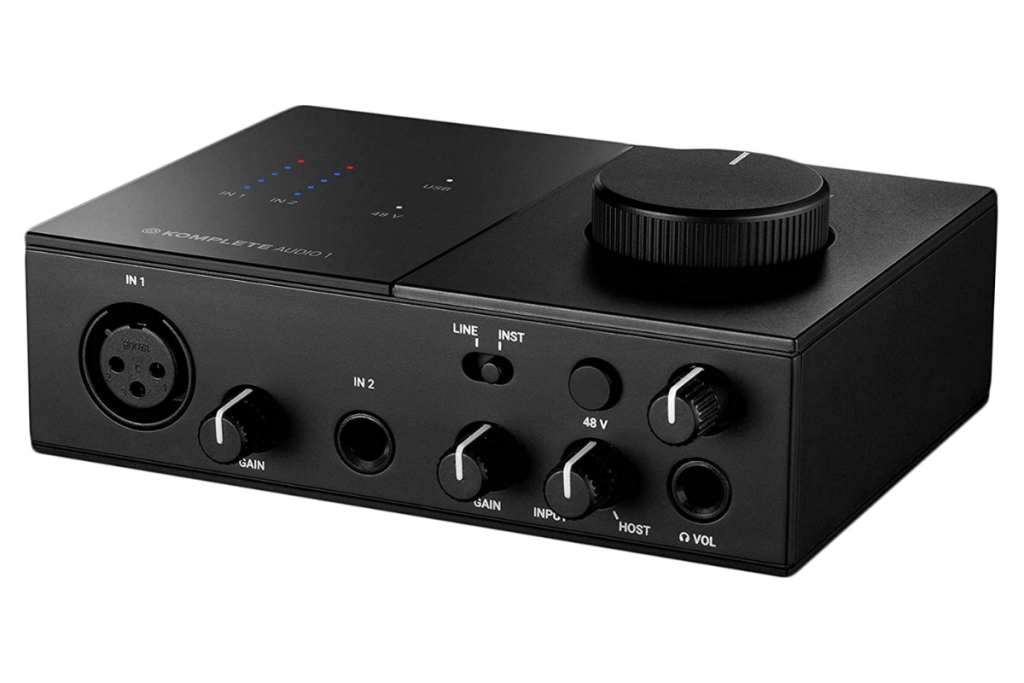
Key Features & Specs
- 1 XLR mic input with phantom power
- 1 ¼″ instrument/line input
- 2 RCA line outputs + headphone out
- Large top-mounted volume knob
- 24-bit / 192 kHz resolution
- USB 2.0 (USB-C compatible)
Best Use Cases, Strengths, and Limitations
| Use Cases | Strengths | Limitations |
| 1. Singer-songwriters recording voice and guitar. 2. Solo musicians building a simple home recording studio. 3. Beginners who want an easy learning curve with helpful software. | 1. Clean, reliable audio performance. 2. Intuitive design with a big volume knob Includes a generous. 3. Native Instruments software package. 4. Compact and straightforward for first-time users. | 1. RCA outputs instead of balanced TRS, less ideal for pro monitors. 2. Only one mic input, limiting flexibility for duos. 3. No MIDI I/O or extra features like loopback. |
Why We Picked It
The Komplete Audio 1 is made for solo musicians.It has one mic input and one instrument input, ideal for singer-songwriters recording vocals and guitar.The bundled Komplete software gives beginners the tools to start creating right away.
Check Price:
Best Affordable Two-Input Interface – Behringer UMC202HD
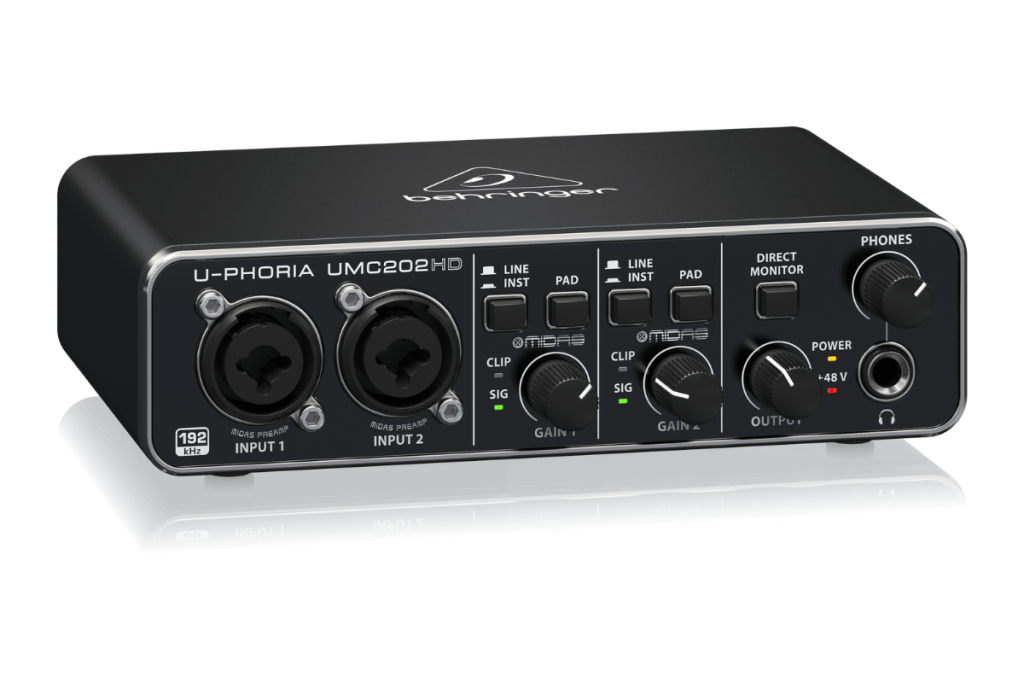
Key Features & Specs
- 2 XLR/¼″ combo inputs with Midas-designed preamps
- 2 balanced line outputs + headphone output
- +48V phantom power for condenser mics
- 24-bit / 192 kHz resolution
- Direct monitoring switch for latency-free monitoring
- USB 2.0 connection
Best Use Cases, Strengths, and Limitations
| Best Use Cases | Strengths | Limitations |
| 1. Singer-guitarists recording both tracks at once. 2. Beginner podcasters with two microphones. 3. Affordable starter option for a home recording studio. | 1. Extremely affordable for a dual-input interface. 2. Clean Midas preamps with phantom power support. 3. Latency-free direct monitoring. 4. Durable metal build. | 1. No MIDI I/O for keyboards or synths. 2. No dedicated monitor control or extra output routing. 3. Driver setup on Windows can be tricky (requires ASIO driver). |
Why We Picked It
The UMC202HD is one of the cheapest ways to record two sources at once.
With clean preamps and solid resolution, it’s a great budget interface for beginners recording vocals and instruments together.
Check Price:
Spec Comparison
| Model | Resolution | Inputs | Outputs | MIDI | Connectivity | Direct Monitoring |
| Focusrite Scarlett Solo (4th Gen) | 24-bit/192 kHz | 2 (1 mic + 1 instrument) | 2 × ¼″ TRS (balanced) | No | USB-C (USB 2.0) | Yes |
| Universal Audio Volt 1 | 24-bit/192 kHz | 1 (XLR/¼″ combo) | 2 × ¼″ TRS (balanced) | Yes (1×1) | USB-C (USB 2.0) | Yes |
| Arturia MiniFuse 1 | 24-bit/192 kHz | 1 (XLR/¼″ combo) | 2 × ¼″ TRS (balanced) | No | USB-C (USB 2.0) | Yes |
| PreSonus Studio 24c | 24-bit/192 kHz | 2 (XLR/¼″ combos) | 2 × ¼″ TRS (balanced) | Yes (1×1) | USB-C (USB 2.0) | Yes |
| Behringer UMC202HD | 24-bit/192 kHz | 2 (XLR/¼″ combos) | 2 × ¼″ TRS (balanced) | No | USB 2.0 (Type-B) | Yes |
| Native Instruments Komplete Audio 1 | 24-bit/192 kHz | 2 (1 mic + 1 instrument) | 2 × RCA (unbalanced) | No | USB 2.0 | Yes |
How to choose the correct audio interface?
Filter by your real needs, not hype.
Decide how many inputs you’ll actually use and whether you need extras like MIDI or loopback. Ignore fancy specs you’ll never touch.
Check retailer listings carefully.
Prices swing often. Look at trusted retailers for current availability, and make sure the exact model generation (e.g., 4th Gen Scarlett Solo) matches what you’re buying.
Read user comments and reviews.
Specs look good on paper, but reviews reveal real-world issues like driver stability, build quality, or noise levels. Pay special attention to reviews from people using the same computer setup as you.
Confirm compatibility before purchase.
For Windows, make sure proper ASIO drivers are available. For Mac, check for class-compliant plug-and-play support. Also, confirm it works with your DAW (recording software) of choice.
Frequently Asked Questions about a beginner-friendly audio interface around $150
Which budget audio interface is best?
The Focusrite Scarlett Solo (4th Gen) is often considered the best budget audio interface under $150. It’s easy to use, has clean sound, and works well for solo singers, podcasters, or anyone starting a home recording studio. If you want warmer vocals, the UA Volt 1 is also a great pick.
What is a good beginner audio interface?
A good beginner interface should be simple, reliable, and affordable. Models like the Scarlett Solo, Arturia MiniFuse 1, or PreSonus Studio 24c fit that description. They don’t overload you with complex controls but still give you the key features: phantom power for condenser mics, direct monitoring to avoid delay, and solid preamps for clean recordings.
Do you need an audio interface as a beginner?
If you’re just casually using your laptop mic for calls, no. But if you want to record music, vocals, podcasts, or instruments with good quality, then yes, you need an audio interface. Built-in sound cards on computers are noisy and weak; an interface gives you clean input and proper outputs for headphones and speakers.
Is it worth buying an audio interface?
Yes. Even a budget audio interface improves your recordings drastically. You will experience clearer vocals, reduced background noise, and the ability to connect professional microphones and instruments. It also makes mixing easier because your playback through headphones or monitors is more accurate. Think of it as the foundation of a small studio.
What does 2 in 2 out audio interface mean?
“2 in / 2 out” means the interface has two inputs (usually for mics or instruments) and two outputs (usually for connecting speakers or studio monitors). For example, you could record a singer and guitar at the same time (2 in), and then play back through left and right monitor speakers (2 out).
What is the difference between 2.0 and 2.1 audio?
This refers to speaker setups, not interfaces:
- 2.0 audio = two speakers (left and right) with no subwoofer.
- 2.1 audio = two speakers (left and right) plus one subwoofer for low frequencies (the “.1”).
For most home recording studio beginners, 2.0 is enough, since studio monitors are designed to give a balanced sound without a subwoofer.
Glossary
- Bit Depth / Resolution (24-bit): How detailed the recording is — higher means cleaner sound.
2. Sample Rate (48 kHz, 192 kHz): How often sound is captured per second — higher means more accuracy.
3. Dynamic Range: The difference between the softest and loudest sound that it can handle.
4. XLR Input: Standard round plug for microphones.
5. ¼″ Instrument / Hi-Z Input: Input for guitars or instruments.
6. Combo Jack: One socket that accepts both XLR and ¼″ plugs.
7. Balanced Output (TRS/XLR): Noise-free outputs for studio monitors.
8. RCA Output: Consumer-style outputs, usually for speakers or hi-fi gear.
9. 2-in/2-out: Two inputs for recording, two outputs for playback.
10. Preamps: Circuits that boost weak mic signals so they’re clear.
11. Phantom Power (+48V): Power needed for condenser microphones.
12. Direct Monitoring: Hear yourself in real time without computer delay.
13. MIDI I/O: Ports for keyboards, drum machines, or MIDI controllers.
Conclusion
The right audio interface isn’t just about specs. It’s about eliminating obstacles so you can concentrate on your creative process. Each of the options here offers something unique, from simplicity to warm vocal tone to streaming features. Pick the one that fits your workflow, plug it in, and start recording. Once you hear the difference, you’ll wonder how you ever worked without it.
